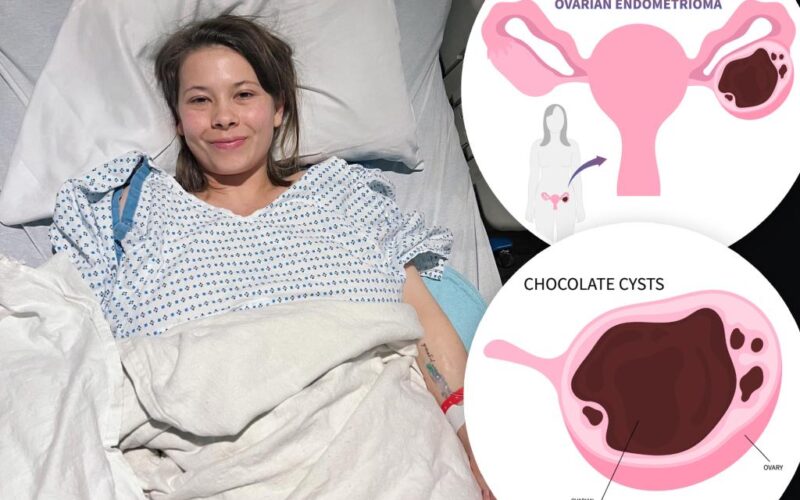You wouldn’t want to find one in your candy box.
Bindi Irwin has revealed that she is rebounding from major double surgery after three years of “fighting for answers” about her health issues — and it included removal of a whole organ as well as a “chocolate cyst.”
“Fifty-one endometriosis lesions, a chocolate cyst, and my appendix were all removed across two surgeries,” she wrote in an Instagram post. “I can FINALLY say that I’m feeling better. Genuinely healing. I can function in everyday life without wanting to throw up or pass out from the pain.”
While many women are familiar with endometriosis — which is when tissue, similar to the lining of your uterus, starts growing outside it — “chocolate cysts” may not be on your radar.
In endometriosis, the misplaced tissue acts just like the uterine lining: thickening, bleeding, and shedding with each menstrual cycle.
Common symptoms of endometriosis include pelvic pain, exhaustion, pain during intercourse, heavy periods, infertility, back pain, nausea and vomiting, bloating, an increasing urge to urinate, pain when peeing or pooping, and excessive menstrual cramps.
When this tissue attaches to the ovaries, it can be filled with old blood, with turns the color of chocolate.
Ovarian endometriomas, or “chocolate cysts,” can be very small, grow very large, and involve one or both ovaries.
Endometriosis affects one in ten women worldwide, according to the Cleveland Clinic. Of that population, 7% to 44% will develop ovarian endometriomas.
On average, it takes about a decade from the first signs of symptoms for a woman to finally be diagnosed with endometriosis.
Oftentimes, symptoms are dismissed by either healthcare providers or women themselves who believe that even extreme menstrual pain — the kind that causes fainting or vomiting — is just a normal part of womanhood.
“Stigma is lingering and alive,” Dr. Tamer Seckin, an endometriosis specialist, previously told The Post. “Nobody believes it when women have pain.”
“Looking back, every woman I’ve treated over the last 30 years has carried a story of pain, of being dismissed, of fighting invisible battles that no one believed.”
Bindi’s endometriosis battle
This grin and bear it ethos echoes the experience of Irwin, who first shared her endometriosis diagnosis over two years ago.
She gave an update on her health on the February 3 episode of the “A Life of Greatness” podcast, sharing that she dealt with a decade of daily fatigue as a result of her condition.
“I went for 10 years undiagnosed because doctors really didn’t know enough, they diagnosed me with a million other things, like IBS, or hormones, or ‘It’s just part of being a woman,’” she explained.
“The symptoms continued to snowball, and it took me such a long time to find help.”
Endometriomas like the ones Irwin recently had removed are signs of a more advanced stage of endometriosis.
Irwin first underwent surgery to treat her condition in March 2023.
What are complications of chocolate cysts?
Beyond severe pelvic pain, complications of ovarian endometriomas include constipation, inflammation of the ovaries and fallopian tubes, an increased risk of ovarian cancer, infertility as a result of scar tissue, and the possibility of an endometrioma rupture, wherein the cyst opens and leaks, causing additional pain.
However, when they’re small and don’t cause pain, they do not require treatment — but may be monitored.
How are they diagnosed?
These cysts are initially diagnosed via pelvic exam and imaging procedures like a transvaginal ultrasound or MRI. An official diagnosis is made when the cyst is removed laparoscopically and sent to a lab for biopsy.
How are chocolate cysts treated?
There is no known cure for ovarian endometriomas. Treatment is dependent on factors such as age, symptoms, and reproductive goals.
Options include medications that regulate hormones, including birth control pills, patches, vaginal rings, or IUDs.
They may also be removed via laparoscopic surgery. Cyst removal typically improves symptoms and reduces the risk of rupture or infertility.
Irwin was inspired to share her journey in part to destigmatize endometriosis and raise awareness about issues related to women’s health.
“I felt utterly ashamed as a teenager and young adult being told that my pain was just part of being a woman. I felt lesser. I felt hurt. I felt weak. Young girls and women shouldn’t feel alone with pain in the driver’s seat of their lives. We need to take away the stigma of talking about women’s health. It’s time to have open discussions and make change on a global scale,” she said in her latest Instagram post.
In May, The Seckin Endometriosis Research Center for Women’s Health opened at Cold Spring Harbor Laboratory (CSHL) on Long Island, made history as the first research facility within a top US scientific institution solely focused on unraveling the mysteries of the painful condition.








